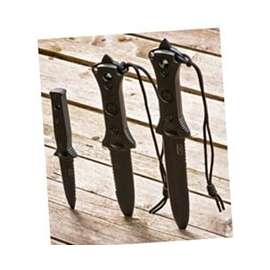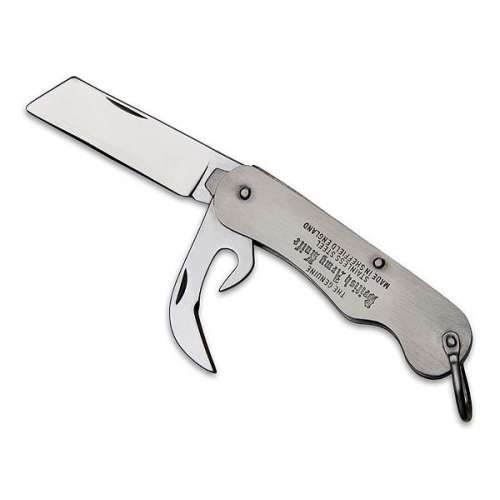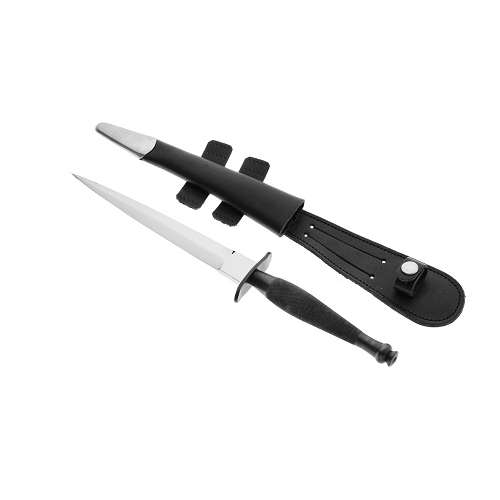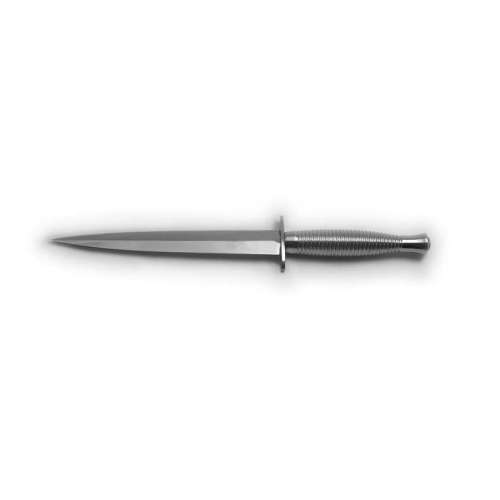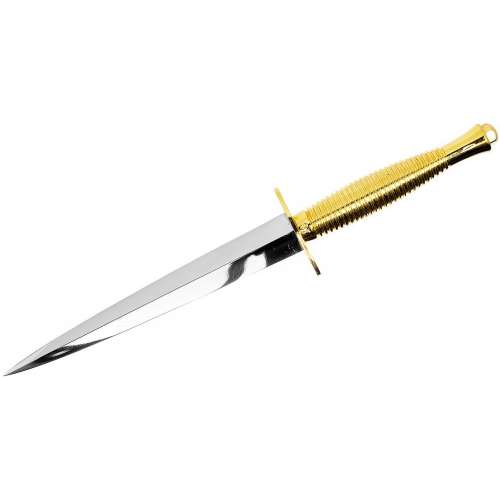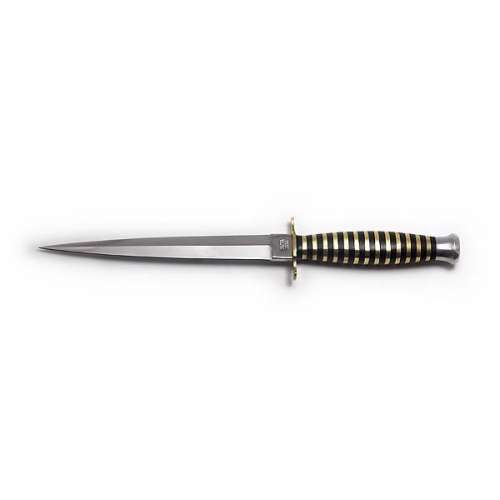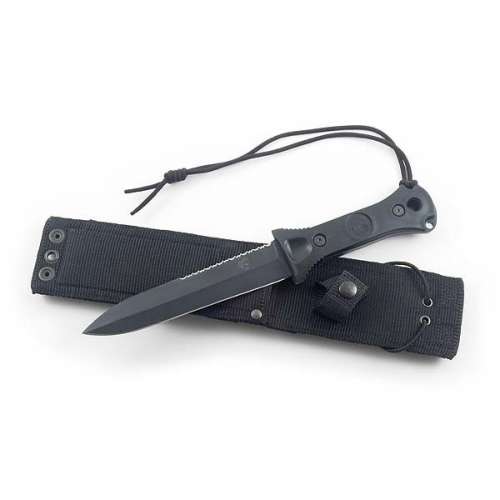No products
Product successfully added to your shopping cart
There are 0 items in your cart. There is 1 item in your cart.
Tactical Knives
Tactical knives are sturdy, reliable and purpose-driven tools designed primarily for military, law enforcement and emergency use. They are also extremely popular amongst outdoor enthusiasts. At Samuel Staniforth, we offer both fixed blades and folding knives, depending on the intended use and personal preference.
Our tactical knives feature a ...
Tactical knives are sturdy, reliable and purpose-driven tools designed primarily for military, law enforcement and emergency use. They are also extremely popular amongst outdoor enthusiasts. At Samuel Staniforth, we offer both fixed blades and folding knives, depending on the intended use and personal preference.
Our tactical knives feature a sharp, durable blade in various styles and are built to withstand rigorous use. The design emphasises functionality, ease of use and reliability in time-sensitive and high-stress situations.
History of Tactical Knives
Our knife experts at Samuel Staniforth explore the history of the tactical fighting knife, tracing its evolution from the 20th century to the present day.
Origins
The history of these knives dates back to the 20th century when military forces first started issuing specialised knives to their soldiers. The famous Fairbairn Sykes Fighting Knife, developed during World War II, was designed for close combat and served as an early predecessor for modern tactical fighting knives.
Evolution
During the years following WW2, the development of tactical knives continued in response to the evolving needs of military personnel and law enforcement officers. For example, the KA-BAR knife, initially issued to the USMC during WW1, remains a popular knife today because of its rugged design and versatility. Then, as time went on, folding knives gained popularity due to their portability and ease of use.
Today
In the 21st century, tactical fighting knives come in a wide variety of styles, shapes and materials to cater to different users’ needs and preferences. In fact, the evolution of tactical knives reflects the continuous refinement and adaptation of these tools to meet the changing requirements of those who use them.
Common Uses For Tactical Knives
Designed for a range of purposes, these knives can be used for:
Self-defence - Quick-draw design and secure grip enable effective protection in dangerous situations. This is the reason why military and law enforcement often carry these types of knives.
Outdoor activities - They serve multiple functions when camping, hiking or hunting. These include tasks such as cutting rope, preparing food or even starting a fire with the knife’s spine.
Everyday use - Many people carry one for everyday use, taking advantage of its reliability, durability and versatility. It can be used for tasks such as opening packages or performing small repairs.
Characteristics of a Tactical Knife
At Samuel Staniforth, we recommend that you consider the following factors before selecting your knife:
Blade Material & Durability
When choosing the right knife for you, it is important to consider the blade material and its durability. While most tactical knives feature steel blades, the type of steel can have a significant impact on the blade’s strength, edge retention, corrosion resistance and ease of sharpening.
For example, high-carbon steel knives offer excellent durability and edge retention whereas stainless steel knives provide superb corrosion resistance. The bottom line is to choose a knife material that aligns with the demands of your intended usage.
Handle Ergonomics
Another factor to consider when choosing a tactical knife is the handle’s ergonomics and comfort. The handle should fit comfortably in your hand and provide a secure grip, even in wet or slippery conditions. When evaluating handle options, remember to consider factors such as:
Weight
Grip security
Potential slipperiness
Size & Weight
The final factor to bear in mind when selecting your tactical knife is size and weight. Whether you plan to carry your knife every day or only on specific occasions, the size should be comfortable and convenient.
FAQs
What Are The Different Types of Tactical Knife?
The two primary types of tactical knives are fixed blade and folding knives:
Fixed - Fixed knives are generally more robust, versatile and dependable. The lack of moving parts makes them less likely to break or wear out over time. They are more suitable for heavy-duty tasks such as chopping, prying and self-defence.
Folded - Folding knives are typically more compact, easier to carry and more discrete. More often than not, they feature a locking mechanism for added safety during use.
On top of these, there are also speciality tactical knives such as rescue knives, dive knives and combat knives.
What Type of Blade Shapes Do Tactical Knives Come In?
On top of blade type, there are also different point of blade types to consider when selecting your tactical knife, including:
Drop point blade - This type of tactical knife features a sloping spine and a gradually curved cutting edge. They are very versatile and suit various cutting tasks such as slicing, carving and piercing.
Spear point blade - Spear point tactical knives are symmetrical in shape, with both the spine and cutting edge converging at the tip, making them excellent for thrusting and piercing tasks.
Why Are Tactical Knives So Useful?
These knives are highly valued for their versatile design, dependable performance, and wide range of applications. Whether it's for self-defence, emergency situations or everyday use, tactical fighting knives are extremely useful for a range of tasks.
How Do I Look After My Tactical Knife?
A tactical knife’s lifespan is affected not only by how you use it but also by how you store it. As a result, it is imperative that you store your knife properly to keep it in optimal condition and prevent accidental injuries. Sheaths are an excellent option for safe storage.
At Samuel Staniforth, our “Tank” Todd knife and Parry knives all come with sheaths included.
How Do I Clean My Tactical Knife?
Regular cleaning and maintenance of your knife is crucial when it comes to prolonging its lifespan and performance. Here are some of our top tips:
Clean each part of the knife using a soft cloth or brush and a gentle cleaning solution, taking care not to damage the blade or handle materials. Avoid using harsh chemicals or abrasive materials that could damage your knife.
Once the knife is clean and dry, apply a thin layer of protective oil to the blade.
Remember to store your knife in a cool place away from direct sunlight. Prolonged exposure to moisture or heat can damage the blade and handle materials.
How Do I Handle My Tactical Knife Safely?
Whether you’re a seasoned professional or new to the world of knives, understanding safe knife-handling techniques is essential.
Here are some of the fundamental rules to follow when using your tactical knife:
Always cut away from your body
When handing the knife to another person, hold it by the spine with the blade facing down
Treat every knife, regardless of size or purpose, with the same level of caution and respect
What Accessories Can You Get For Your Tactical Knife?
When choosing your tactical knife, it’s important to consider the sheath and carrying options best suited to your needs. Typically, the sheath should be durable and secure, ensuring that the knife stays put during transport and offers quick and easy access when required.
British Army Clasp Knife Range - 3 Variations British Army Clasp Knife Range - 3 Variations
British Army Clasp Knife Range - Available in 3 Variations British Army Clasp Knife Range -...
(Please allow 7-14 days before dispatch as knives are made to order).Fairbairn Sykes Knife 1st Pattern Fairbairn Sykes Knife 1st Pattern
Polished carbon steel blade, with a knurled steel handle plus leg sheath. Polished carbon steel blade, with a...
(subject to availability )Fairbairn Sykes Knife 3rd Pattern Fairbairn Sykes Knife 3rd Pattern
Fairbairn / Sykes Commando Knife Fairbairn / Sykes Commando Knife
(subject to availability )Gold Plated Fairbairn Sykes w/Presentation Case. Gold Plated Fairbairn Sykes w/Presentation...
GOLD Plated Ceremonial F/S Commando Knife. GOLD Plated Ceremonial F/S Commando...
(subject to availability )Wasp Commando Fairbairn Sykes Wasp Commando Fairbairn Sykes
WASP Pattern Fairbairn Sykes Commando Knife. WASP Pattern Fairbairn Sykes Commando...
(subject to availability )
Categories
Wishlist
Information
New products
-

Serrated Slicer PINK Handle
Versatile Slicing Knife Pink handle. Available in 8", 10", and 12"...
£ 15.75 -

-

Specials
-

4 Piece Steak Knife Set Coloured Curly Birch
MADE IN SHEFFIELD 4 Piece Steak Knife...
£ 120.00 -20% £ 150.00

